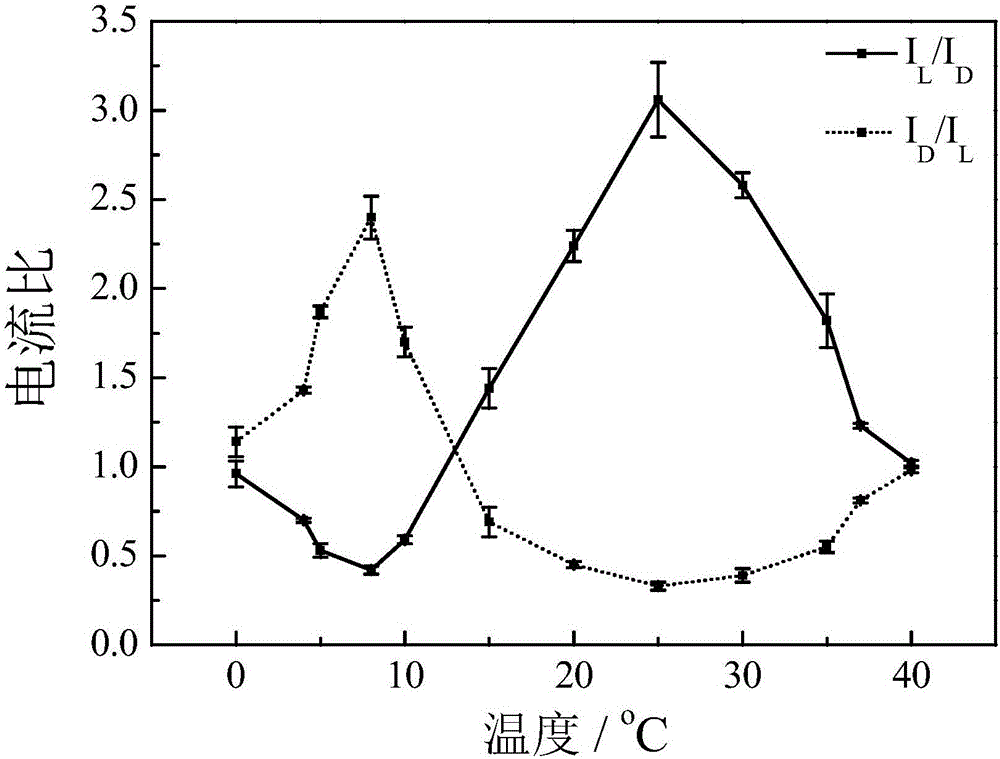Preparation of temperature sensitive quinine chiral sensor and application thereof in electrochemical recognition of tryptophan enantiomer
A tryptophan enantiomer and sensor technology, applied in the fields of biotechnology and electrochemical research, can solve the problems of complex operation, inability to detect, weak absorption, etc., and achieve the effects of simple preparation method and excellent identification performance.
- Summary
- Abstract
- Description
- Claims
- Application Information
AI Technical Summary
Problems solved by technology
Method used
Image
Examples
Embodiment 1
[0019] The preparation of quinine chiral sensor includes the following steps:
[0020] (1) The experiment adopts a three-electrode system, the glassy carbon electrode (diameter 3mm) is used as the working electrode, the platinum sheet electrode is used as the counter electrode, and the saturated calomel electrode (SCE) is used as the reference electrode, which is immersed in the prepared 5mmol / L quinine solution In , a quinine-modified electrode was prepared by applying a potential deposition of -1.0V for 600s by the potentiostatic method.
[0021] (2) The experiment adopts a three-electrode system. The quinine-modified electrode is used as the working electrode, the platinum electrode is used as the counter electrode, and the saturated calomel electrode (SCE) is used as the reference electrode. / D-tryptophan solution, after standing still for 60s, carry out differential pulse scanning, the recognition effect diagram of tryptophan enantiomer is shown in figure 1 , it can be s...
Embodiment 2
[0023] The preparation of the temperature-sensitive quinine chiral sensor and its application in electrochemical recognition of tryptophan enantiomers are the same as in Example 1.
[0024] At different temperatures, the effect of quinine chiral sensor on the recognition of tryptophan enantiomers was investigated. The prepared quinine-modified electrodes were respectively immersed in the prepared L- / D-tryptophan solution with a concentration of 0.5mmol / L. After standing for 60s, differential pulse scanning was performed. The experimental temperature was 0-40°C. The recognition effects of tryptophan enantiomers at different temperatures are shown in figure 2 , it can be seen that the chiral sensor has a better recognition effect on D-tryptophan at 8°C, and has a better recognition efficiency on L-tryptophan at 25°C.
PUM
| Property | Measurement | Unit |
|---|---|---|
| Diameter | aaaaa | aaaaa |
Abstract
Description
Claims
Application Information
 Login to View More
Login to View More - R&D Engineer
- R&D Manager
- IP Professional
- Industry Leading Data Capabilities
- Powerful AI technology
- Patent DNA Extraction
Browse by: Latest US Patents, China's latest patents, Technical Efficacy Thesaurus, Application Domain, Technology Topic, Popular Technical Reports.
© 2024 PatSnap. All rights reserved.Legal|Privacy policy|Modern Slavery Act Transparency Statement|Sitemap|About US| Contact US: help@patsnap.com










